Abstract
Muscarinic receptors stimulate the secretion of acid pepsinogen and mucous in gastric mucosa. Whether muscarinic receptors are involved in the pathogenesis of benign gastric disease is unknown. Receptor changes in these conditions were therefore sought. An autoradiographic technique was developed to determine quantitatively muscarinic receptors in microtome sections of biopsy specimens obtained during gastroscopy. Muscarinic receptor density was mean (SEM) 18.4 (1.2) fmol/mg protein in the corpus and 8.9 (0.7) fmol/mg protein in the antrum (n = 53). Neither chronic nor active gastritis was associated with receptor changes in the antrum but chronic gastritis was associated with a receptor loss in the corpus. Patients with acute or recent duodenal or antral ulcers (n = 23) had significantly higher levels of muscarinic receptors in the corpus than controls (n = 25) (22.2 (1.5) v 16.9 (1.7) fmol/mg protein respectively (p < 0.025). These results suggest that muscarinic M3 receptor is overexpressed in duodenal ulcer disease and may play a part in its pathogenesis.
Full text
PDF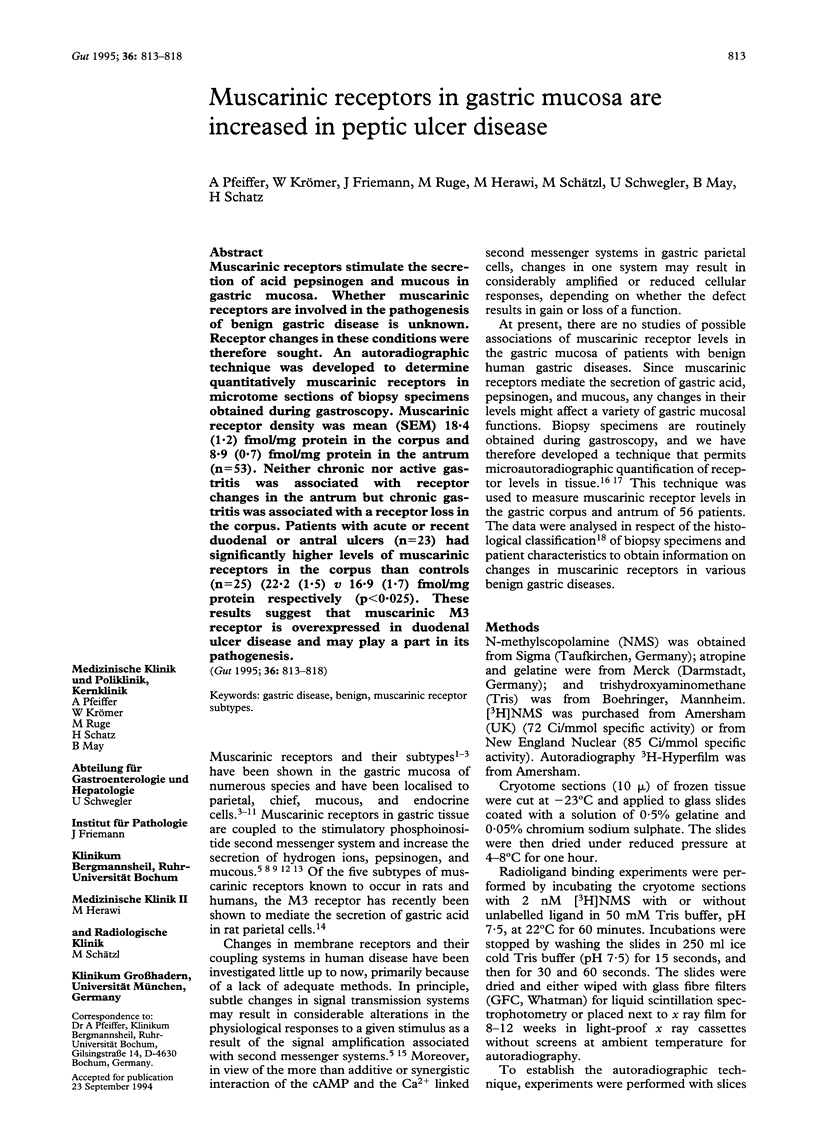
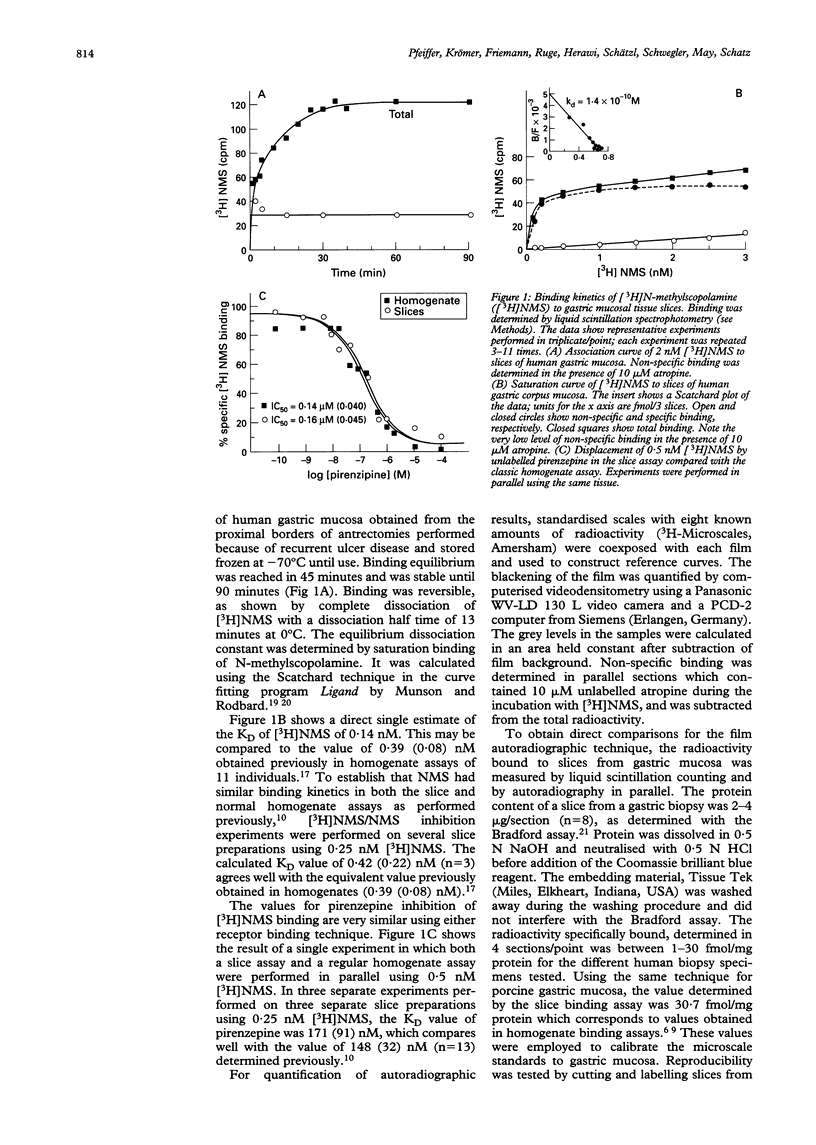
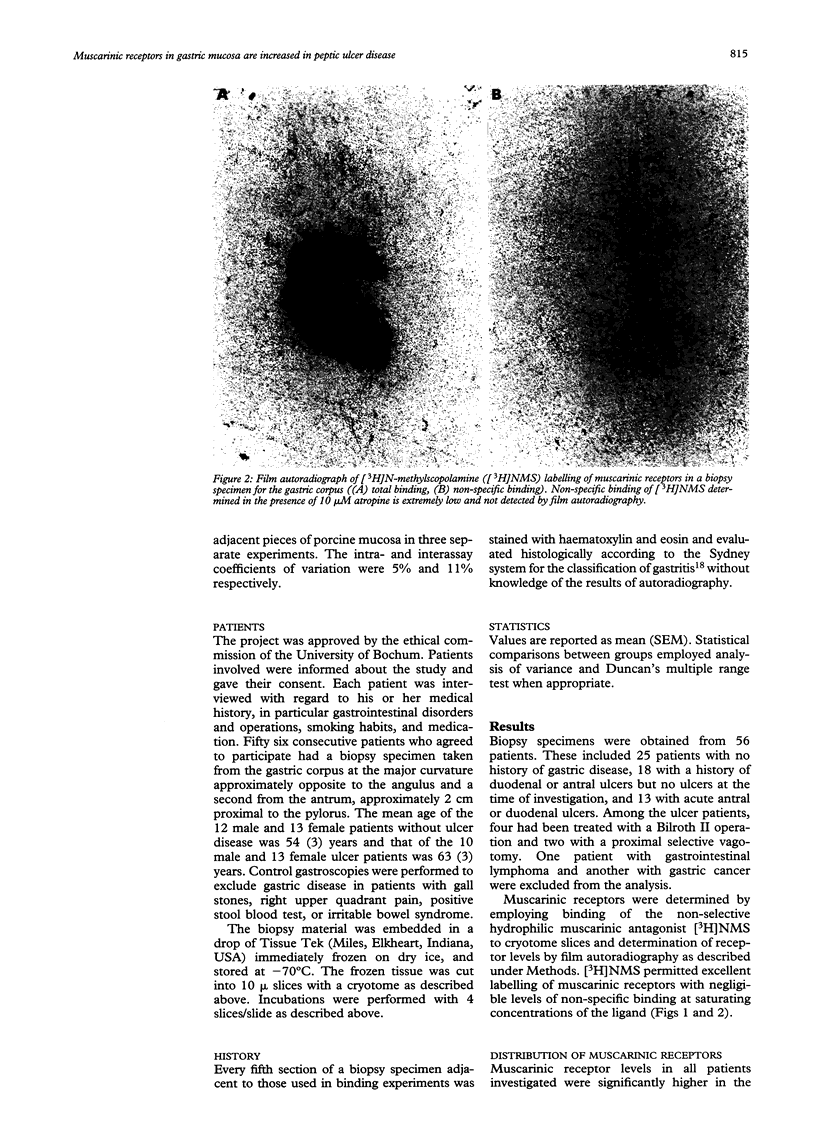
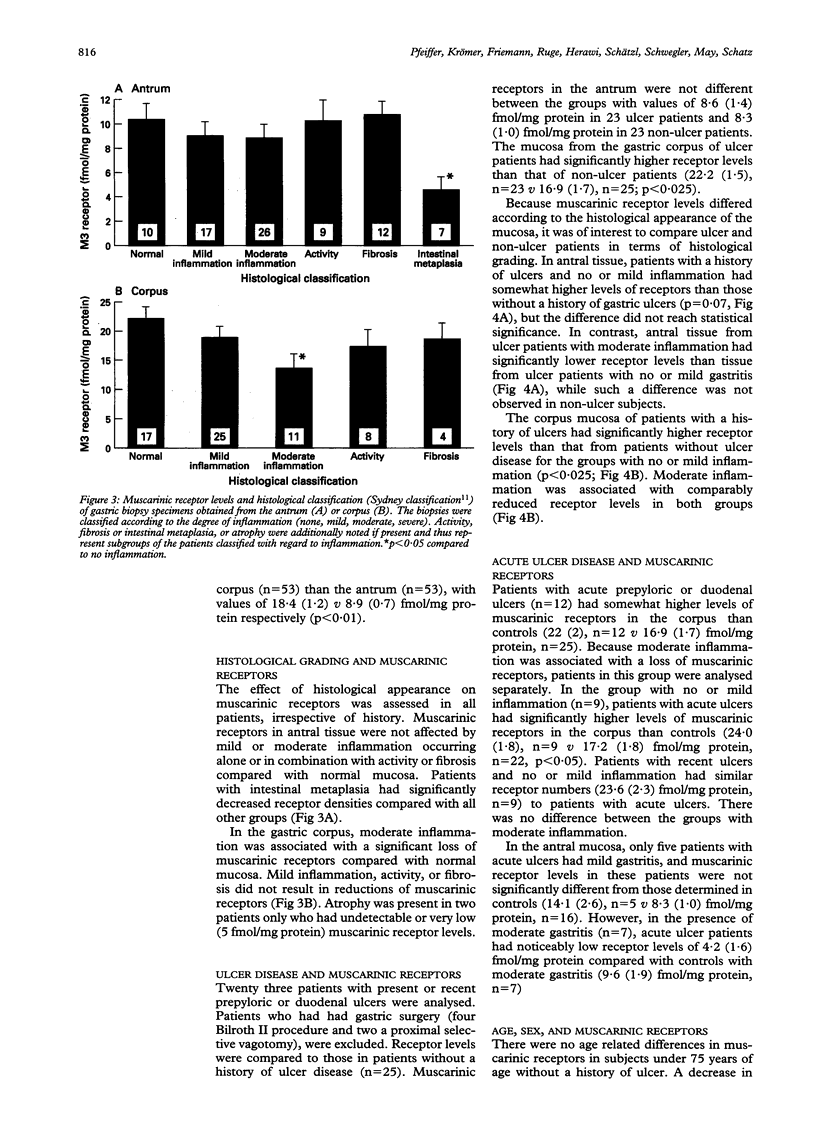

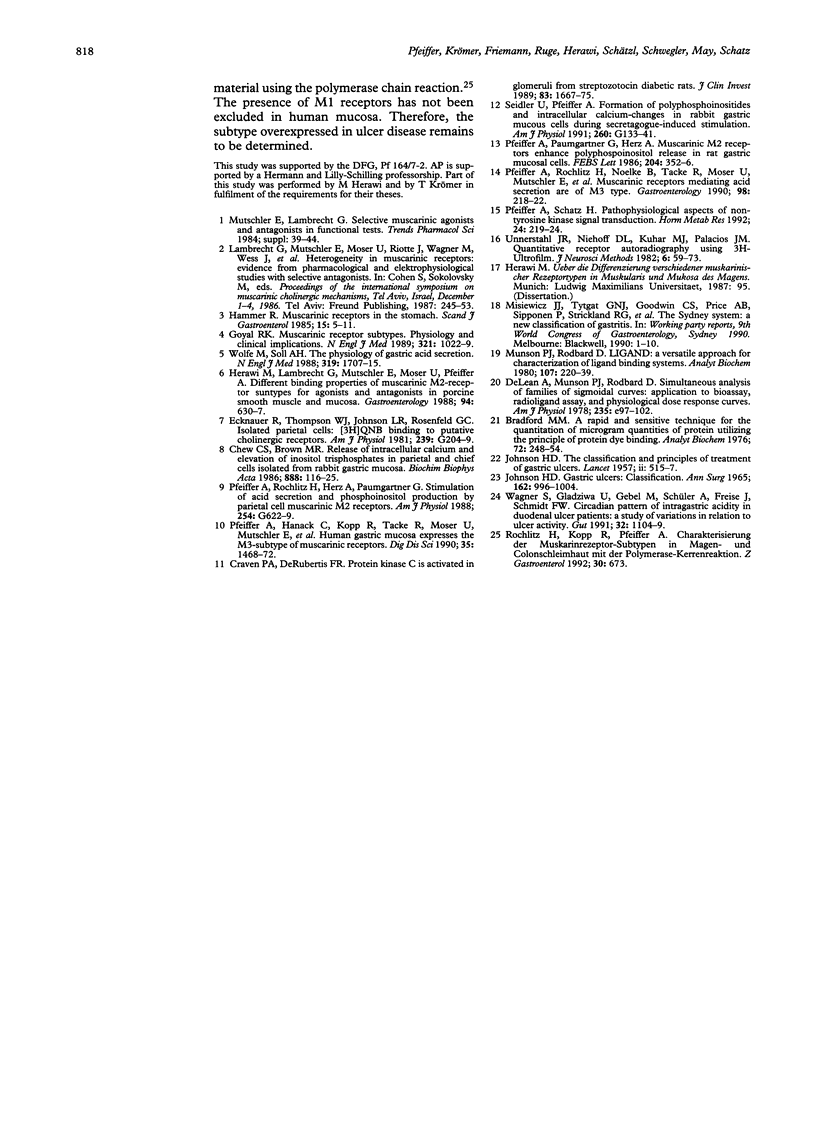
Images in this article
Selected References
These references are in PubMed. This may not be the complete list of references from this article.
- Bradford M. M. A rapid and sensitive method for the quantitation of microgram quantities of protein utilizing the principle of protein-dye binding. Anal Biochem. 1976 May 7;72:248–254. doi: 10.1006/abio.1976.9999. [DOI] [PubMed] [Google Scholar]
- Chew C. S., Brown M. R. Release of intracellular Ca2+ and elevation of inositol trisphosphate by secretagogues in parietal and chief cells isolated from rabbit gastric mucosa. Biochim Biophys Acta. 1986 Aug 29;888(1):116–125. doi: 10.1016/0167-4889(86)90077-7. [DOI] [PubMed] [Google Scholar]
- Craven P. A., DeRubertis F. R. Protein kinase C is activated in glomeruli from streptozotocin diabetic rats. Possible mediation by glucose. J Clin Invest. 1989 May;83(5):1667–1675. doi: 10.1172/JCI114066. [DOI] [PMC free article] [PubMed] [Google Scholar]
- DeLean A., Munson P. J., Rodbard D. Simultaneous analysis of families of sigmoidal curves: application to bioassay, radioligand assay, and physiological dose-response curves. Am J Physiol. 1978 Aug;235(2):E97–102. doi: 10.1152/ajpendo.1978.235.2.E97. [DOI] [PubMed] [Google Scholar]
- Ecknauer R., Thompson W. J., Johnson L. R., Rosenfeld G. C. Isolated parietal cells: [3H]QNB binding to putative cholinergic receptors. Am J Physiol. 1980 Sep;239(3):G204–G209. doi: 10.1152/ajpgi.1980.239.3.G204. [DOI] [PubMed] [Google Scholar]
- Goyal R. K. Muscarinic receptor subtypes. Physiology and clinical implications. N Engl J Med. 1989 Oct 12;321(15):1022–1029. doi: 10.1056/NEJM198910123211506. [DOI] [PubMed] [Google Scholar]
- Herawi M., Lambrecht G., Mutschler E., Moser U., Pfeiffer A. Different binding properties of muscarinic M2-receptor subtypes for agonists and antagonists in porcine gastric smooth muscle and mucosa. Gastroenterology. 1988 Mar;94(3):630–637. doi: 10.1016/0016-5085(88)90233-8. [DOI] [PubMed] [Google Scholar]
- JOHNSON H. D. The pathogenesis of peptic ulcers. Lancet. 1957 Sep 14;273(6994):515–517. doi: 10.1016/s0140-6736(57)90824-3. [DOI] [PubMed] [Google Scholar]
- Johnson H. D. Gastric ulcer: classification, blood group characteristics, secretion patterns and pathogenesis. Ann Surg. 1965 Dec;162(6):996–1004. doi: 10.1097/00000658-196512000-00005. [DOI] [PMC free article] [PubMed] [Google Scholar]
- Munson P. J., Rodbard D. Ligand: a versatile computerized approach for characterization of ligand-binding systems. Anal Biochem. 1980 Sep 1;107(1):220–239. doi: 10.1016/0003-2697(80)90515-1. [DOI] [PubMed] [Google Scholar]
- Pfeiffer A., Hanack C., Kopp R., Tacke R., Moser U., Mutschler E., Lambrecht G., Herawi M. Human gastric mucosa expresses glandular M3 subtype of muscarinic receptors. Dig Dis Sci. 1990 Dec;35(12):1468–1472. doi: 10.1007/BF01540563. [DOI] [PubMed] [Google Scholar]
- Pfeiffer A., Paumgartner G., Herz A. Muscarinic M2-receptors enhance polyphosphoinositol release in rat gastric mucosal cells. FEBS Lett. 1986 Aug 18;204(2):352–356. doi: 10.1016/0014-5793(86)80842-0. [DOI] [PubMed] [Google Scholar]
- Pfeiffer A., Rochlitz H., Herz A., Paumgartner G. Stimulation of acid secretion and phosphoinositol production by rat parietal cell muscarinic M2 receptors. Am J Physiol. 1988 Apr;254(4 Pt 1):G622–G629. doi: 10.1152/ajpgi.1988.254.4.G622. [DOI] [PubMed] [Google Scholar]
- Pfeiffer A., Rochlitz H., Noelke B., Tacke R., Moser U., Mutschler E., Lambrecht G. Muscarinic receptors mediating acid secretion in isolated rat gastric parietal cells are of M3 type. Gastroenterology. 1990 Jan;98(1):218–222. doi: 10.1016/0016-5085(90)91314-v. [DOI] [PubMed] [Google Scholar]
- Pfeiffer A., Schatz H. Pathophysiological aspects of non-tyrosine kinase signal transduction. Horm Metab Res. 1992 May;24(5):219–224. doi: 10.1055/s-2007-1003297. [DOI] [PubMed] [Google Scholar]
- Seidler U., Pfeiffer A. Inositol phosphate formation and [Ca2+]i in secretagogue-stimulated rabbit gastric mucous cells. Am J Physiol. 1991 Jan;260(1 Pt 1):G133–G141. doi: 10.1152/ajpgi.1991.260.1.G133. [DOI] [PubMed] [Google Scholar]
- Unnerstall J. R., Niehoff D. L., Kuhar M. J., Palacios J. M. Quantitative receptor autoradiography using [3H]ultrofilm: application to multiple benzodiazepine receptors. J Neurosci Methods. 1982 Jul;6(1-2):59–73. doi: 10.1016/0165-0270(82)90016-4. [DOI] [PubMed] [Google Scholar]
- Wagner S., Gladziwa U., Gebel M., Schüler A., Freise J., Schmidt F. W. Circadian pattern of intragastric acidity in duodenal ulcer patients: a study of variations in relation to ulcer activity. Gut. 1991 Oct;32(10):1104–1109. doi: 10.1136/gut.32.10.1104. [DOI] [PMC free article] [PubMed] [Google Scholar]
- Wolfe M. M., Soll A. H. The physiology of gastric acid secretion. N Engl J Med. 1988 Dec 29;319(26):1707–1715. doi: 10.1056/NEJM198812293192605. [DOI] [PubMed] [Google Scholar]



